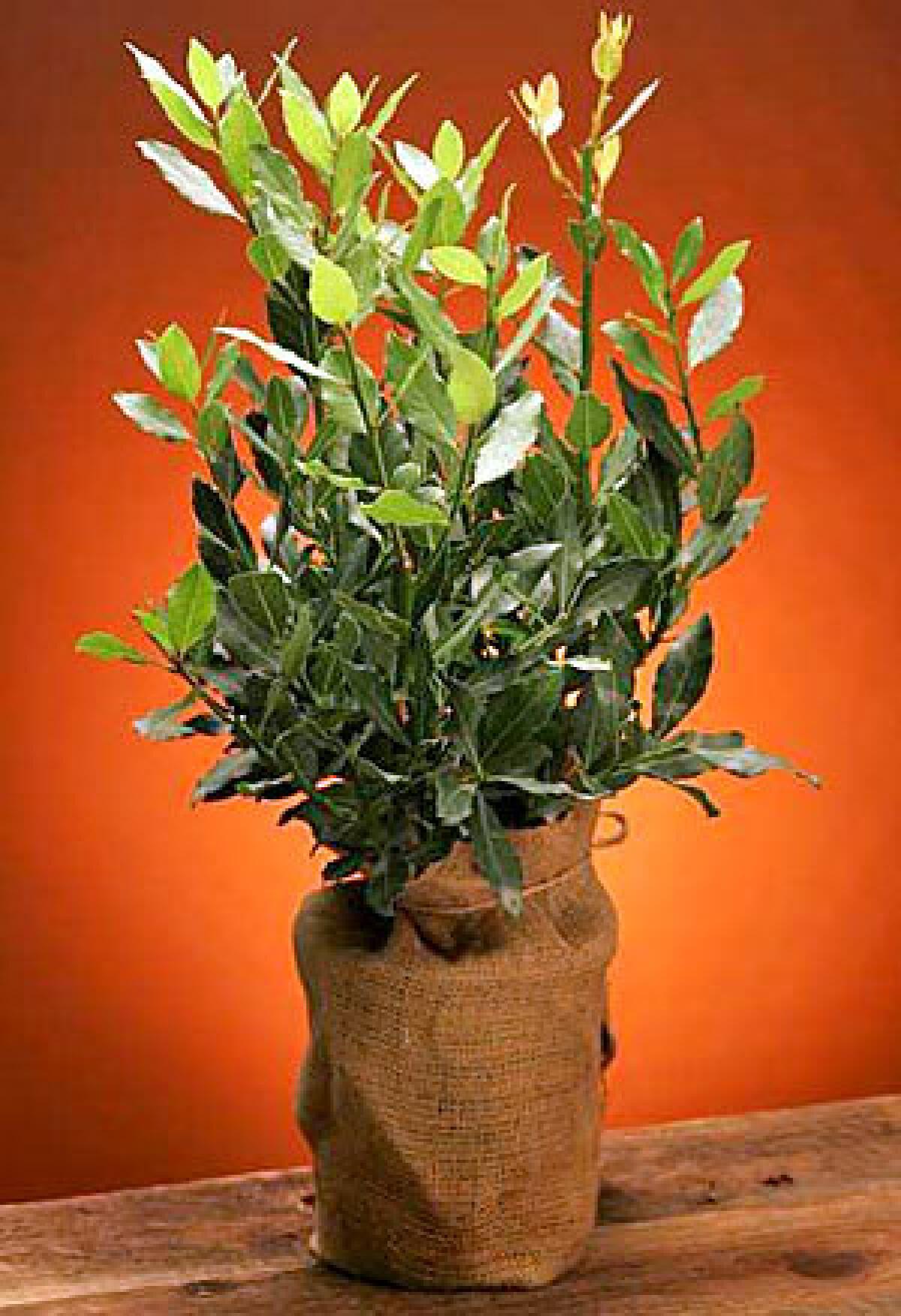Add fresh bay leaves to recipes for aromatic appeal

- Share via
So many things in recipes are optional. But if you live in Southern California, and you lack that bay leaf for a soup, stew or roast, it’s almost criminal to cook without it.
This is the one place in North America with a Mediterranean climate. As such, we have fresh bay leaves attached to actual bay trees, which grow so well that you even see them used as hedges.
The sight of a bay tree is the cue to pluck a few leaves and head on to the nearest farmers market. Whatever you buy there will taste better because of the leaves in your pocket.
For dishes that are boiled or braised, the astringency imparted by the bay leaf becomes the spine of the flavor structure. For roasts, you can use many more leaves, and in this case, it’s the aromatics that come into play.
But before you go a-plucking, then a-cooking, make sure that you have the right sort of tree. We’re so spoiled for fresh bay trees here that we have two common types, one native, one an import from the Mediterranean.
The native one, Umbellularia californica, is the rarer. In the wild, our native bay trees tend to occur in woodsy arteries along canyons and foothills to about 5,000 feet, where they enjoy the company of conifers and oaks. When they’re found in developed areas, they’re generally huge, broad-canopied specimen trees -- holdovers from pioneer days, when they were often planted with eucalyptus, for which their elliptical, light green leaves might well have been mistaken. Their bark is brown, the flowers that appear from winter solstice through spring are yellow, but the best way to identify them is the scent.
As morning fog dissipates and sun finally cooks the dew off their leaves, a bewitching aroma almost like good after-shave rises, then mingles confusingly with the smell of the car exhaust and citrus blossom that constitutes the greater atmosphere of Los Angeles.
Go for Mediterranean
THEIR leaves can be used for cooking and are found in tribal recipes and herbals, and even used in a crossover capacity in European dishes. Yet in flavor, aroma and even in behavior in the cook pot, California bay is more like a native sage, to my taste better suited for the perfume counter than the kitchen. So the remainder of this article is strictly about the much more commonly planted Mediterranean bay.
This is the international culinary standard for bay, the bay laurel tree, also called sweet bay, Turkish bay, or to the botanically correct, Laurus nobilis.
For the historically minded, the most fascinating things about the bay laurel tree are its roots in Greek mythology and romance languages from Apollo onward. Southern Californian garden designers like how well these sturdy green trees tolerate wanton irrigation and take hard pruning into thick, tall privacy hedges. Here and now, however, it makes sense to cut straight to the stem, where you’ll be plucking one leaf for stews and as many as two dozen for a roasting tray full of potatoes and onions.
Like the California bay, the leaves of Laurus nobilis have essential oils that give them pungency and aroma. But these elliptical, olive-green leaves are far more reluctant to give up their goods.
The leaves are so tough that when you see a bay sapling in a nursery, its tag will probably carry the sales pitch “deer resistant.” It would be a hungry ruminant that would happily browse on leaves with so much cellulose, or, as my friend, plant chemist John Fellman, puts it, “dry weight per unit surface.”
The leaves are so rugged that during drought, they stubbornly brown at the tips instead of wilting. Even after cooking, the leaves refuse to disintegrate, a quality that gives them a reputation as a choking hazard and inspired the 1993 New Yorker cartoon “Bay-leaf Watch.” In this, a lifeguard stationed in a fancy dining room shouts through a megaphone, “You, in the dark-green three-piece suit, eating the bouillabaisse! You’ve got one on your spoon! Repeat -- you’ve got one on your spoon!”
Releasing the magic
AS BAY laurel leaves cook, the shape holds, but the volatile chemicals are released. These, says Fellman, also evolved to deter predators. But what deer don’t like, we do -- in moderation.
Four years ago, Turkish researchers from Zonguldak Karaelmas University took the time to tweak apart these chemicals and classify their aromas. They found odors redolent of sweet apple, eucalyptus, flowers, olive oil, cloves, pepper and, less appetizingly, of wet paper and plastic.
Though the highest concentration of oils was found in young leaves in July, pluckers please note: The best flavor was detected in October.
The art in cooking with the leaves is to capture the flavors you want and escape the ones you don’t. San Francisco chef Judy Rodgers recalls as a young cook thinking, “If one bay leaf is good, more are better.” She doesn’t remember how many she put in a duck braise, just that “When I pulled that puppy out of the oven at quarter to 6, it was terrible. You could not eat it. It was like biting into an Excedrin.”
So for a bouquet garni for a braise or stew, as a rule, Rodgers warns, one bay leaf will do.
But rules change for roasting. Mozza chef Nancy Silverton has been known to hand friends a basket and send them down the road from her house with instructions to pick a dozen or more. Then Silverton likes to stud a roasting pan filled with potatoes, sweet onions, fennel or combinations of the three, with 10 or even 20 bay leaves.
Silverton would never do this in a stew, but in the roasting pan, she’s capturing the aromatics so closely guarded by those tough leaves without unleashing too much astringency.
The roasted leaves look so beautiful in the finished dish that, bay-leaf lifeguards aside, it’s impossible not to eat one.
It disintegrates like paper on the tongue.
It’s good!
That begs a second.
By the third, your tongue will be going a bit numb and you appreciate why deer steer clear of bay leaves. Instinct will tell you to stick to the potatoes, whose caramelized edges, roasting juices and rising steam will be impregnated by the arresting aromatics of summer, captured and released by bay leaves.
More to Read
Sign up for The Wild
We’ll help you find the best places to hike, bike and run, as well as the perfect silent spots for meditation and yoga.
You may occasionally receive promotional content from the Los Angeles Times.










